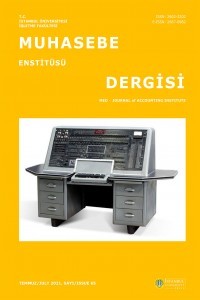Akademik Dergilerin İntihal Politikalari Üzerine Bir Değerlendirme
Bu modern teknolojik çağda intihal çok önemli ve tartışmalı bir konudur ancak acı gerçek şu ki bu konu çok az kişi tarafından incelenmiştir. Gelişmiş veya gelişmekte olan her ülkede, intihal suçu işlenmektedir. Elbette, bunun oranı ve yoğunluğu gelişmekte olan ülkelerde, gelişmiş ülkelere göre daha yüksektir. İntihal, birçok ülkede farklı alanlarda ve türlerde ortaya çıkar. İntihal birçok şekilde olabilir ancak kısaca başkalarına ait olan eserleri kendininmiş gibi göstererek etik olmayan bir davranış içerisinde olmaktır. Tüm dünyada olduğu gibi Türkiye’de de, son on yılda Yüksek Lisans ve Doktora mezunlarının sayısı artmıştır. İntihal söz edildiğinde, insanlar çoğunlukla öğrenciler tarafından yapılan intihal hakkında düşünür, ancak akademisyenler veya yazarlar her zaman göz ardı edilir. Bu çalışmada, akademisyenler ve yazarlar tarafından makale gönderilen dergilerin intihal politikalarını ve dergilerin bu konuya verdiği önemi inceleyeceğiz. Her derginin intihal politikasına ilişkin kendi kuralları ve düzenlemeleri vardır, ancak asıl soru, intihal önlemeye yönelik politikalar yeterli midir? Eğer öyleyse, bir makale yayınlarken politikalarını gerçekten uyguluyorlar mı?
Anahtar Kelimeler:
İntihal Politikaları, Akademik Dergiler, Türkiye
An Assessment on Plagiarism Policies of Journals
Plagiarism is a very important and debated topic in this modern technological world , however, this issue has been explored by very few people. In every developed or developing country, the crime of plagiarism is committed. Of course, the proportion and intensity of this is higher in developing countries than in developed countries. Plagiarism occurs in many countries in different areas and types. Plagiarism can be of many kinds, but in short it is an unethical way of showing the works belonging to others as if they were his own. In Turkey, as in all the world, the number of master’s and doctoral graduates has increased in the last decade. When plagiarism is mentioned, people mostly think about plagiarism done by students, but academicians or authors are always ignored. In this study, we will examine the plagiarism policies of journals to which articles are submitted by academics and authors, and the importance that journals give to this subject. Every single journal has its own rules and regulations regarding its plagiarism policy, but the question is, are those policies enough to prevent plagiarism? If so, do they really implement their policies while publishing an article?
Keywords:
Plagiarism Policies, Plagiarism, Turkey,
___
- JournalPark. Retrieved from https://dergipark.org.tr/page/about
- International Journal of Islamic Economics and Finance Studies Plagiarism Policy. Retrieved from https://dergipark.org.tr/ijisef/page/3858
- Social Sciences Research Society Journal Author Guidelines. Retrieved from http://dergipark.ulakbim.gov.tr/nwsasocial/about/submissions#copyrightNotice
- TÜBİTAK Academic Journals Instruction for Authors. Retrieved from http://journals.tubitak.gov.tr/medical/i2csag.pdf
- Karabag, S. F., and Berggren, C. (2012). Retraction, dishonesty and plagiarism: Analysis of a crucial issue for academic publishing, and the inadequate responses from leading journals in economics and management disciplines. Journal of Applied Economics and Business Research, 2(3), 172–183.
- Laskar, M. (2017). Publishing articles in scientific journals: a concern for research misconduct or dishonesty (fabrication, falsification and plagiarism). Mediscope, 4(2), 1–4.
- Hong, S. T. (2017). Plagiarism continues to affect scholarly journals. Journal of Korean medical science, 32(2), 183-185.
- Thomas, A., and De Bruin, G. P. (2015). Plagiarism in South African management journals. South African Journal of Science, 111(1/2). (n.d.). Retrieved from http://www.sobiad.org/eJOURNALS/journal_IJSS/index.html
- International Journal of Economics and Financial Issues. (n.d.). Retrieved from https://www.econjournals.com/index.php/ijefi/about/editorialPolicies#custom-1S.r.o., I. S. (n.d.). International Journal of Economic Sciences. Retrieved from https://www.iises.net/publication-ethics-publication-malpractice-statement.htmlPLAGIARISM POLICY. (n.d.). Retrieved from https://ijrcs.org/plagiarism-policy/
- International Journal of Business, Accounting and Management. (n.d.). Retrieved from http://www.doarj.org/ijbam/open-access-policy-and-ethics/Admin. (n.d.). About Us. Retrieved from https://jafas.org/about-this-journal/(n.d.). Retrieved from http://dergipark.gov.tr/mufider/page/5352ADAM AKADEMİ. (n.d.). Retrieved from http://www.adamakademi.com/site/content/yayin_ilkeleri
- Shashok, K. (2011). Authors, editors, and the signs, symptoms and causes of plagiarism. Saudi Journal of Anaesthesia, 5(3), 303. doi:10.4103/1658-354x.84107
- Uçak, N. Ö, & Birinci, H. G. (2008). Scientific Ethics and Plagiarism. 187-204.Toprak, Z. (2017). Academic Writing in Turkey: Plagiarism and Originality. Boğaziçi University Education Journal, 34(2), 1-12.
- Pennycook, A. (1996). Borrowing Others Words: Text, Ownership, Memory, and Plagiarism. TESOL Quarterly, 30(2), 201. doi:10.2307/3588141
- Grossberg, M. (2017). Plagiarism and Professional Ethics—A Journal Editors View. Academic Ethics,509-516. doi:10.4324/9781315263465-40
- Bozdaric.K.(2012). Plagiarism detection- Quality management tool for all scientific journals. Croatian Medical Journal. 53(1), Page 2. Doi: 10.3325/cmj.2012.53.1
- Roa, T.S. S and Andrade, C. (2014). Policy of the Indian journal of psychiatry on the problem of plagiarism. Indian journal of plagiarism. 53(3), Page.211, Doi: 10.4103/0019-5545.140613.
- Enders.W and Hoover.G.A. (2004). Whose line is this? Plagiarism in economics. Journal of economic literature. 42(2), Page, 492.Doi:10.1257/0022051041409066.
- Zhang.Y.Hand JIA. Xiaoyan.(2012).A survey on the use of Cross Check for detecting plagiarism in journal article. Learning publishing. 25(4). Page. 305, Doi: 10.1087/20120408.
- Wiwanitkit.S.Wiwanitkit.V.(2017). Response of author accused of plagiarism by journal auditors. Science and engineering ethics.23(1). Page.310. Doi:10.1007/s11948-016-9752-7.
- ISSN: 2602-3202
- Yayın Aralığı: Yılda 2 Sayı
- Başlangıç: 1975
- Yayıncı: İstanbul Üniversitesi
Sayıdaki Diğer Makaleler
2018 Yılında Ortada Kâr mı Var, Yoksa Zarar mı?: Türk Hava Yolları Vak’ası
Türkiye’de Muhasebe Mesleğinin Geleceği
KGK İnceleme Raporları Çerçevesinde Türkiye’de Denetim Kalitesi
Akademik Dergilerin İntihal Politikalari Üzerine Bir Değerlendirme
Yasemin AKGÜL, Merve DİKİCİOĞLU, Sheikh Nazmul HUDA
Özkaynağa Dayalı ve Nakde Dayalı Hisse Bazlı Ödemelerin Finansal Performansa Etkileri
Üniversite Öğrencilerinin İntihal Algısı
Kevser TOPÇU, Havva Hidayet GÜRER
40. Yılında Türkiye Muhasebe Eğitimi Sempozyumu
Duygu HAS, Ceren DİNÇEL, Hande Kaygusuzoğlu
Sanayi Devrimi Sonrası Avrupa ve Amerika'da Ticaret Eğitimi
İşletmelerde Kurumsal Risk Yönetimi ve İç Denetime Farklı Bir Bakış Açısı 5S Uygulaması
